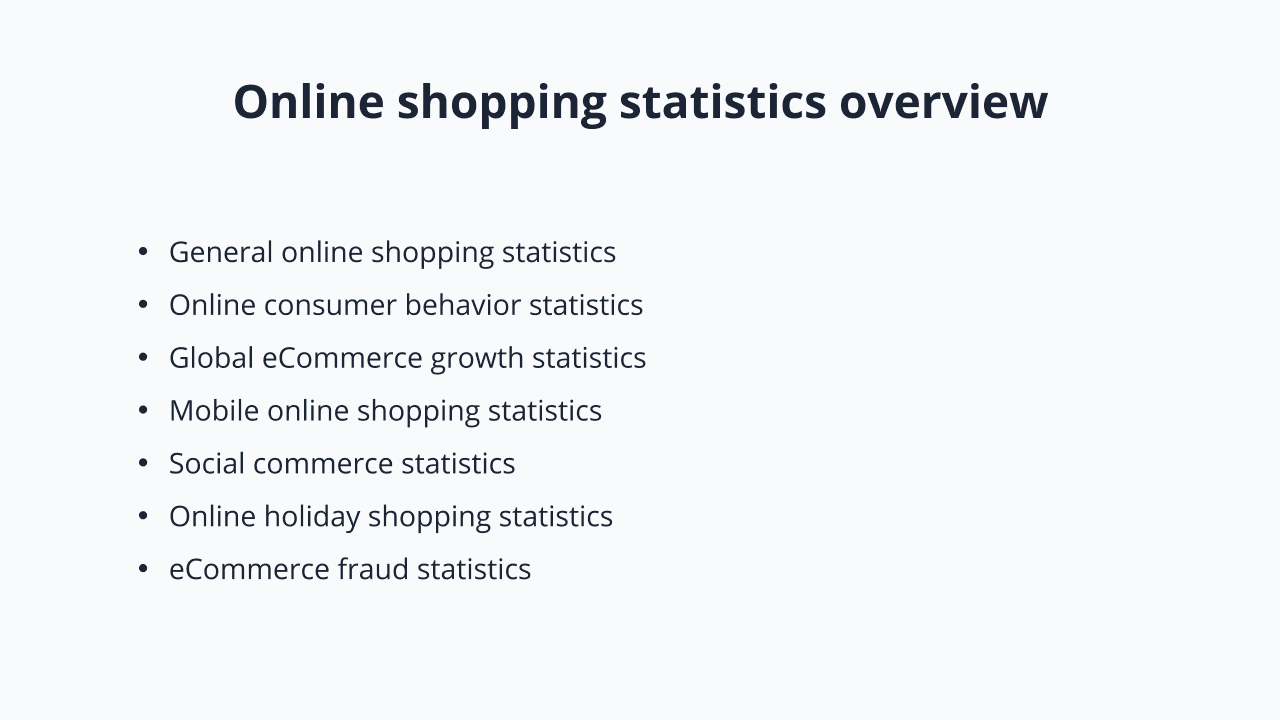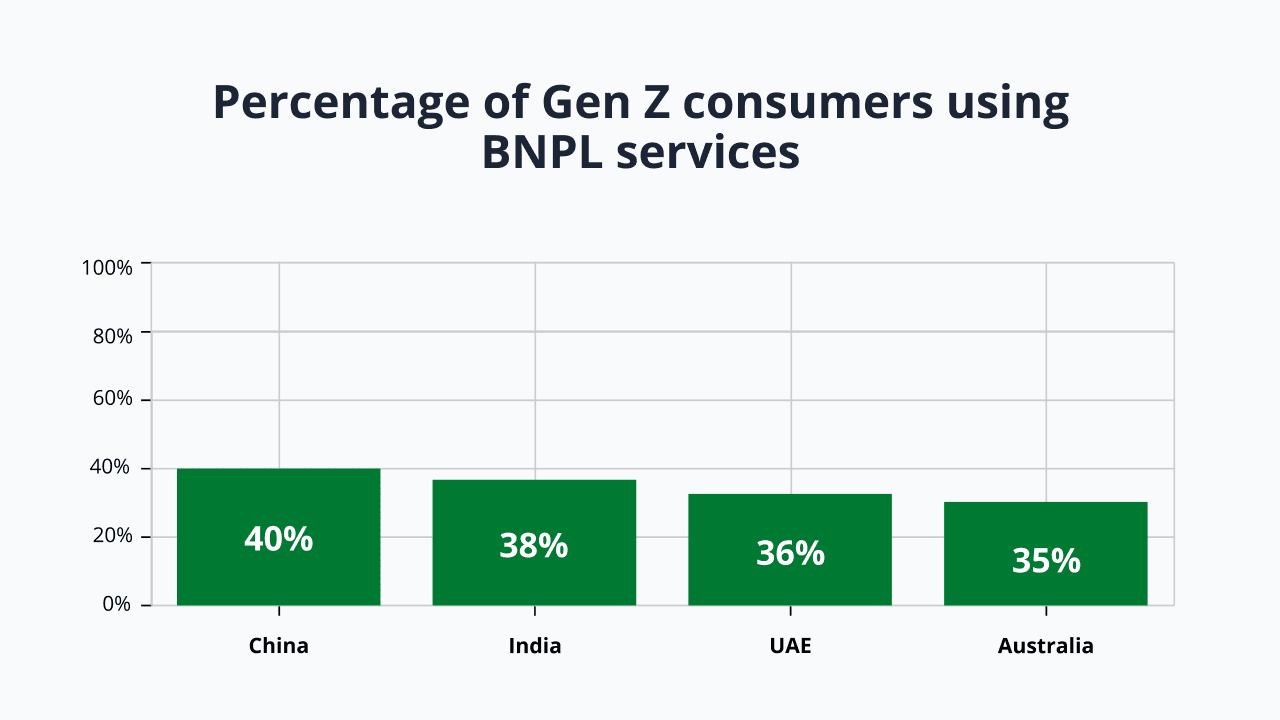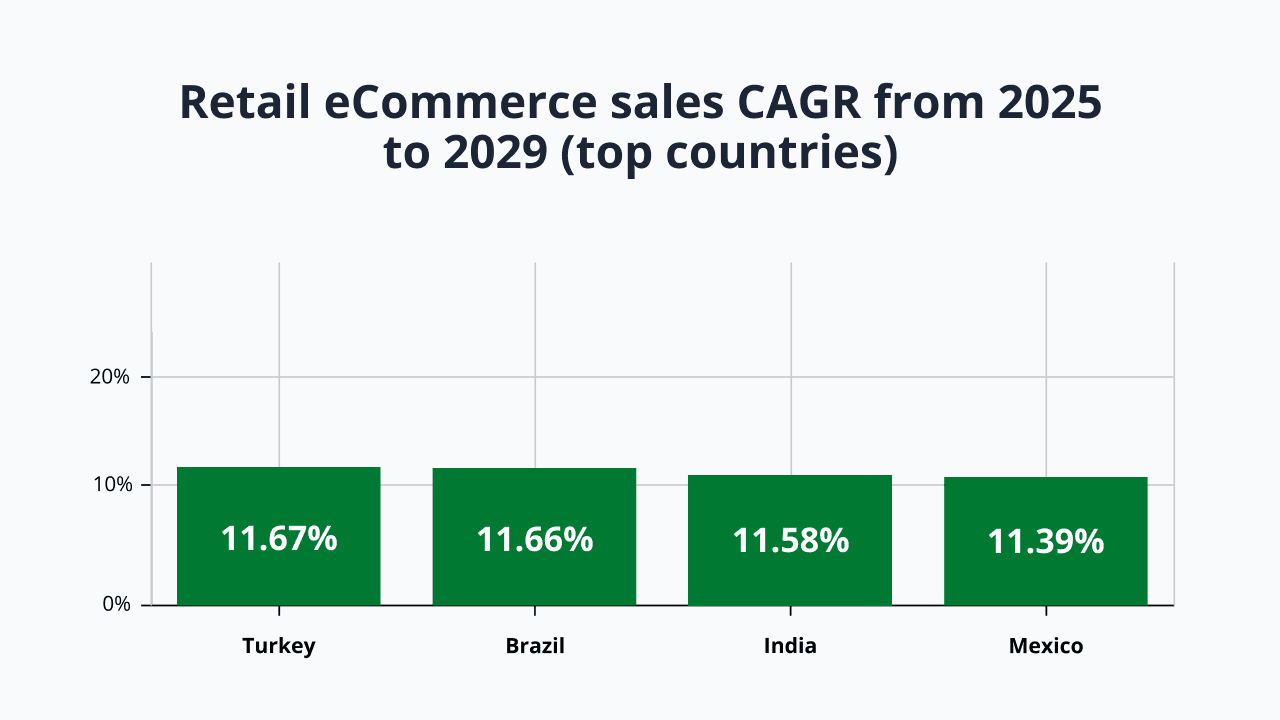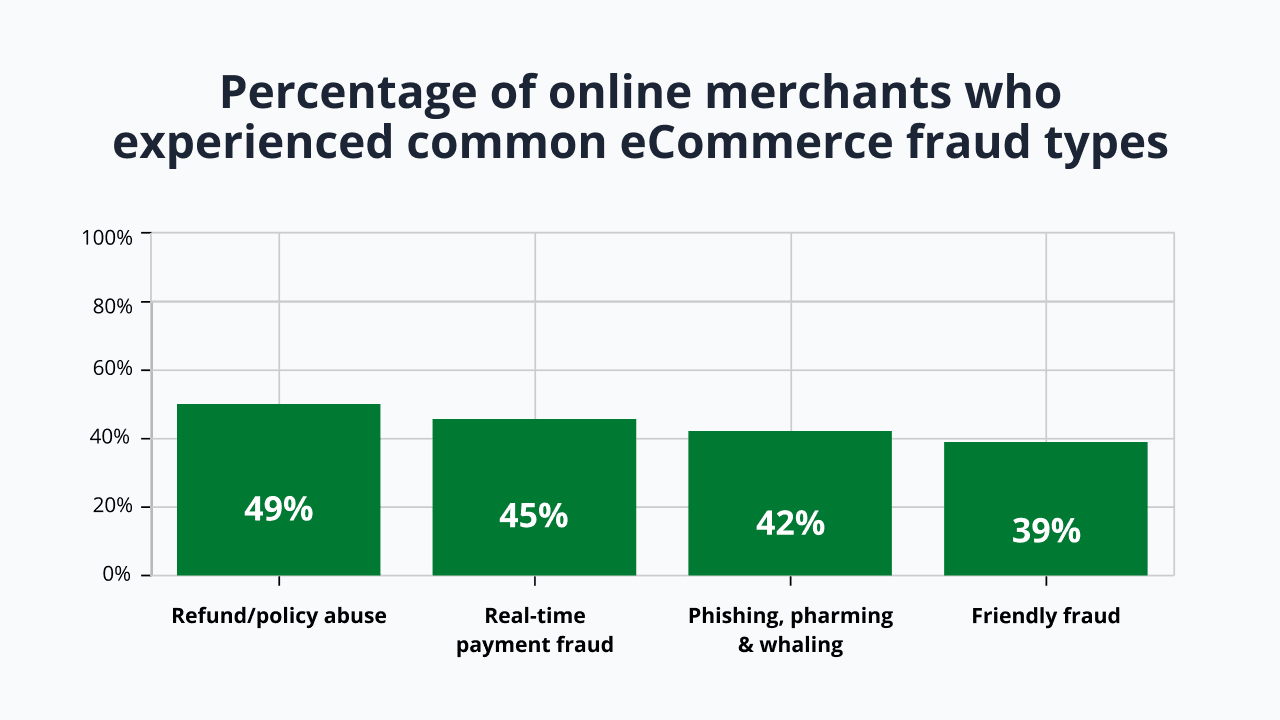Key takeaways:
- The online shopping industry is rapidly expanding, with consumers spending billions of dollars on online transactions annually.
- Artificial Intelligence (AI) is increasingly personalizing the online shopping experience, while smartphones are becoming the primary medium for buying products online.
- Knowing what makes shoppers abandon carts and what features they value helps businesses attract and keep customers.
If you’re planning to start your online business, it’s best to learn about the current online shopping landscape. Extensive research will uncover valuable insights that will help you strategize your business decisions.
In this article, we’ll examine online shopping statistics from various trusted industry experts, like eMarketer and Statista, and explore the reasons why eCommerce is growing.

General online shopping statistics
1. Global eCommerce sales will likely reach $6.8 trillion by 2028. (Forrester)
These projections show that 24% of retail sales worldwide will comprise global eCommerce sales by 2028. Business owners should take this steady increase as a sign to set up their online stores if they haven’t already done so.
2. The U.S. retail eCommerce sales reached an estimated $300.2 billion in the first quarter of 2025. (U.S. Census Bureau)
This number was adjusted for seasonal variation and not for price changes. In addition to that, the total retail sales were approximately $1,858.5 billion for the first quarter of 2025.
Now is a good time for U.S. online businesses to research various strategies to help them ride this surge in eCommerce sales. They can improve their social media presence by exploring recent social media marketing trends or making their website mobile friendly.
3. U.S. livestreaming eCommerce sales are projected to reach $68 billion by 2026. (Statista)
This figure is driven by how consumers are more inclined to buy products during a livestream. Customers find it convenient to ask product questions and get instant responses live.
With this insight, companies should consider investing in live selling and organizing livestreams in a proper format. This way, viewers are encouraged to engage and transact with them.
4. eMarketer predicts that TikTok will convert 45.8% of U.S. users into buyers by 2026. (eMarketer)
As online shopping becomes more popular, online business owners can leverage social media to connect and engage with their target market. They could use short-form videos showing product demos or relate trending topics to their products.
5. There was a 6.1% increase in U.S. eCommerce sales from the first quarter of 2024 to the first quarter of 2025. (U.S. Census Bureau)
Total retail sales in the U.S. also increased by 4.5%, indicating that eCommerce growth continues to outpace overall retail expansion. This data should inspire organizations to find more tactics to attract more customers to their online shops.
Strategies like eCommerce content marketing can help convert visitors into buyers by providing them with valuable product content.
6. 58% of business leaders believe that AI chatbots will play a big role in AI-driven personalization on customer journeys. (Twilio Segment)
Various brands see AI’s potential to collect substantial amounts of data on online customers’ behaviors. This information will allow these AI chatbots to tailor experiences for consumers, creating deeper connections between businesses and shoppers.
7. Based on a 2024 global survey on AI adoption, 55% of the participants believe AI can replace human interaction when providing product information before purchases. (Statista)
Although there are some positive insights about AI integration, a lack of expertise in this technology is a major roadblock for businesses and organizations. Companies should see this challenge as an opportunity to explore AI capabilities further.
Investing in research and development targeted at AI adoption could be the first step for business owners to improve customer journeys significantly.
Online consumer behavior statistics
8. In a 2024 survey, 82% of the respondents indicated they were open to using chatbots instead of speaking to customer service agents. (Tidio)
53% of the same respondents pointed out that it was a frustrating experience to have to be put on hold or wait for a reply. Online shoppers prefer fast response times, which influences their purchasing decisions.
9. 47% of online shoppers read customer reviews before buying influencer-recommended products. (PYMNTS)
PYMNTS revealed in their survey that 95% of U.S. consumers usually do supplemental research online before purchasing. Apart from online reviews, they also look through online forums and compare prices across various platforms.
10. 39% of U.S. customers abandon their carts due to high extra costs. (Baymard Institute)
These extra costs include shipping fees and taxes. Additionally, out of 1,026 respondents, 21% abandoned their carts because of slow delivery.
Business owners should investigate possible workarounds to cut down on extra costs. If that route isn’t feasible, they can try compensating with great customer service and thorough communication when setting proper expectations for additional fees.
11. Around 69% of shoppers admit to buying things online while doing other activities. (Salsify)
This trend is called “ambient shopping” and is popular across all age groups and demographics. eCommerce businesses leverage this consumer behavior by allowing them to browse and buy products directly on social apps.
From a customer’s perspective, this is highly convenient, especially when they’re scrolling through online platforms during their downtime. They can easily make online purchases and then get right back to scrolling.
12. 66% of consumers prioritize free shipping when shopping online. (PYMNTS)
Add to that, 50% sought online stores with easy checkout processes and 46% said they wanted to be able to track their deliveries. These figures show how important it is for business owners to consider their customers’ experiences.
Learning about what works for them through surveying focus groups is one good way to discover what consumers want during their online shopping journey.
13. 68% of online shoppers spend an hour or less researching products online. (Salsify)
On the other hand, an estimated 21% spend up to four hours researching. Then, 9% decide to make online purchases within ten minutes or less.
This is where clear and comprehensive product content plays a big role. It’s a smart move for brands to provide consumers with valuable information about their products or services. Why? It will help them feel confident and satisfied with their purchase decisions.
14. 52% of global consumers buy products from international businesses. (Nosto)
Nosto surveyed 2,000 online shoppers across the U.S. and the U.K. They found that 41.30% of those respondents shop internationally because they can buy products at lower prices than at home.
15. More than one-quarter of Gen Z online customers use buy-now-pay-later (BNPL) services. (McKinsey & Company)
This online shopping behavior is seen in respondents across different countries. McKinsey & Company’s study is based on a sample of:
- 1,004 respondents in China
- 1,003 respondents in the UAE
- 991 respondents in India
- 978 respondents in Australia

Source: McKinsey & Company
The data shows that Gen Z consumers are price-conscious and are interested in saving money by using installment methods. Businesses should consider creating more budget-friendly bundles or packages to attract more of this demographic.
16. 87% of online consumers find enhanced product content helpful when making purchase decisions. (Salsify)
According to Salsify and DSI research, enhanced content like interactive videos and comparison charts are more likely to drive customers to buy products.
The results show that we live in an era where multimedia and creativity increase the chances of capturing customers. This challenges entrepreneurs to create new, attention-grabbing content for their products or services.
17. 52% of female shoppers worldwide prefer to purchase clothing and shoes online. (SaleHoo)
In addition to fashion products, 40% of female consumers buy beauty and personal care items online. Two main drivers for this are wider selections and sales promotions they can’t find in physical stores.
This presents an opportunity for online merchants to expand their product variety and strategically plan discounts or exclusive offers.
Global eCommerce growth statistics
18. Growth in the worldwide eCommerce market will slightly decrease from 7.7% to 6.8% in 2025. (eMarketer)
This forecasted dip is due to trade wars in North America and the weakness in China’s current economy. Businesses should know how to navigate these challenging times carefully.
It could be best to plan a strategy that will keep their prices competitive and, at the same time, won’t hurt their profitability in the long run.
19. Turkey’s compound annual growth rate (CAGR) of 11.67% (2025-2029) is the highest among the top 20 global eCommerce markets. (Statista)
Brazil, India, and Mexico follow with CAGRs of 11.66%, 11.58%, and 11.39%, respectively. These figures can help companies in other countries to identify gaps they can fill to increase their CAGRs.

Source: Statista
20. Large eCommerce companies like Amazon and JD.com generate $574.80 billion and $152.80 billion in annual revenue, respectively. (Markinblog)
Amazon continues to thrive as it merges with third-party sellers and extra services. Alternatively, JD.com has solid government support and innovative strategies to expand their company further.
Business owners, whether big or small, can use these major leaders as models for improvement. Examining how they handle operations could help eCommerce businesses reach their full potential.
21. Europe’s eCommerce platform industry has seen an increase in revenue, from $1552.96 million in 2021 to $2975.85 million in 2025. (Cognitive Market Research)
Europe’s eCommerce industry is forecasted to reach $11060.5 million by 2033 with a CAGR of 17.834%. Top business leaders in other continents should lead the way in innovating strategies for increasing online sales revenues.
Again, studying what regions like Europe are doing and how they’re doing it could help entrepreneurs achieve similar CAGRs.
22. Online business owners of eCommerce sites gain major benefits due to the global eCommerce market expansion. (Mordor Intelligence)
An example of this is Shopify merchants seeing a 24% increase in online sales from 2023 to 2024. Online retailers generated $9.3 billion during the 2024 Black Friday-Cyber Monday period.
Mobile online shopping statistics
23. In a 2025 survey, 48% of consumers made recent retail purchases on mobile devices. (PYMNTS)
Approximately 25% of that percentage used their mobile devices to shop in physical stores. This combination of mobile and in-person shopping has been called the “Click-and-Mortar” approach.
It caters to consumers who prefer shopping in physical stores while also getting exclusive deals, coupons, or discounts offered only on mobile apps. It’s an effective way for businesses to increase website and foot traffic simultaneously.
24. More than 55% of mobile shoppers are more likely to engage with eCommerce businesses that provide a digital wallet option for coupons or loyalty cards. (Vibes)
Additionally, 86% of customers will likely engage with product offers sent via SMS as opposed to those sent through email or a mobile app.
25. Approximately 70% of all online sales in the U.S. were from mobile users. (OuterBox)
This percentage has been increasing year-over-year, indicating that customers will likely browse a business’ website on their smartphones or tablets. Entrepreneurs should consider optimizing their eCommerce sites for different screen sizes to offer visitors a great user experience (UX).
26. By 2027, mobile commerce sales will rise, claiming an estimated 49.1% of eCommerce sales. (eMarketer)
This increase is influenced by plenty of factors, such as:
- Mobile technology advancements
- More secure online transactions
- Seamless online shopping experiences
Businesses should constantly improve these aspects to capture potential customers and entice regulars to keep coming back.
27. 40% of consumers will most likely turn to competitors after a poor mobile experience. (OuterBox)
Beyond that, 84% of customers encountered challenges in completing mobile transactions. This data has urged eCommerce businesses to create a smooth mobile shopping experience for their visitors.
28. U.S. mobile commerce sales are projected to reach an estimated $856 billion by 2027. (Statista)
This statistic predicts that in the future, mobile commerce will make up a large percentage of North America’s total retail sales. Considering this, companies should include mobile commerce strategies in their business plans to stay competitive.
Social commerce statistics
29. The U.S. social commerce market will likely reach $114.70 billion in 2025. (GlobeNewswire)
It’s forecasted to grow by 14.4% year-over-year, ultimately expanding to $188.35 billion by 2030.
Business owners should invest in social commerce strategies now, as this growing market indicates a powerful future for direct sales on social platforms. Leveraging these platforms effectively will help capture a larger share of consumer spending.
30. Recent research shows that 69% of customers are inclined to make online purchases because of social media. (Bazaarvoice)
Another 54% claim that they would buy products on social media if they could purchase them without needing to leave online platforms.
To capitalize on this, online stores should integrate seamless in-app purchasing options within their social media presence. Making the buying process effortless will boost conversions significantly.
31. The “TikTok Shop” launching in the U.S. resulted in 57% of social media users finding products through the platform. (The Business Research Company)
This initiative attracted 100,000 creators and 200,000 sellers to cater to online shoppers worldwide.
This presents a chance to explore and actively participate in emerging social shopping features to tap into new consumer discovery channels. Collaborating with creators on social platforms can also increase product visibility.
32. 56% of shoppers plan to keep buying products on social media at a steady level. (Total Retail)
Meanwhile, 32% look forward to increasing social purchases in 2025. Men comprise 38% of these consumers who plan to purchase more on social media platforms.
Businesses need to maintain a consistent and engaging social media presence. They should also regularly update and tailor their product offerings and content, catering to diverse demographics.
33. Latest data reveals that, on average, 32% of customers across global markets use social media for product research. (McKinsey & Company)
Based on a sample of 991 respondents in India, approximately half of the consumers do product research before a purchase. This includes making comparisons and gathering more product information.
34. 54% of Gen Zs prefer to shop on TikTok. (Total Retail)
Additionally, Facebook and Instagram shops have 39% and 29% of social purchases, respectively. This data on shopper preference for social media platforms includes all age groups.
Online holiday shopping statistics
35. During the 2024 holidays, U.S. consumers’ online spending reached $241.4 billion. (Adobe)
This was an 8.7% uptick from the 2023 holiday period. This is a reminder that online merchants should prepare well in advance for the holiday shopping season.
This means optimizing their online stores for high traffic and ensuring sufficient inventory to meet increased demand. Strategic holiday campaigns are important for capturing a share of this major spending period.
36. On Black Friday 2024, 87.3 million Americans shopped online while 81.7 million went to physical stores. (MobiLoud)
This contrast wasn’t too drastic compared to last year’s data. 90.6 million customers made online purchases while 76.2 million shopped in-store.
Online businesses should prioritize their digital presence and promotions for major shopping events like Black Friday. Ensuring a smooth and efficient online shopping experience during this period is key.
37. AI and agents contributed 19% of online holiday purchases in 2024. (Salesforce)
AI and agents leveraged product recommendations, targeted offers, and conversational customer service support to encourage purchasing decisions. This resulted in $229 billion in global eCommerce sales.
It goes on to show how ever-evolving consumer behavior is starting to embrace AI technology.
38. Shoppers saw 7% to 10% discounts across major eCommerce categories over the 2024 Memorial Day weekend. (Adobe)
To attract price-sensitive customers and remain competitive, online businesses should strategically plan promotions and discounts around important holiday weekends. Offering attractive deals on popular categories can help drive sales during these periods.
39. Adobe Analytics’ research revealed that online customers spent $13.3 billion on Cyber Monday 2024. (Adobe)
During this time, consumers took advantage of large discounts on various categories. Televisions and computers were included in these categories with 21.8% and 21.5% off their listed prices, respectively.
40. Traffic to global eCommerce stores grew by 18.94% year-over-year on Black Friday 2024. (Nosto)
It outpaced the 2023 rate, with sales up by 4.19%. The outcome was more muted on Cyber Monday as total sales increased by 0.99%, while traffic was up by 11.43%.
41. According to a recent survey, online holiday shoppers contributed to a total spend of $991.2 million during Cyber Monday 2024. (Adobe)
At a share of 75.2%, consumers used BNPL services for their online purchases. Considering this data, business owners should integrate BNPL options prominently at checkout to cater to consumer payment preferences. Offering flexible payment solutions can reduce cart abandonment rates.
eCommerce fraud statistics
42. On a global scale, eCommerce fraud costs are projected to reach $107 billion by 2029. (Juniper Research)
In 2024, the total cost of eCommerce fraud was $44.3 billion. Considering this, predictions indicate a 141% growth. Juniper Research’s study revealed that AI and refund fraud contribute to this drastic increase.
43. 49% of online merchants experienced refund/policy abuse, making it the most common eCommerce fraud in 2024. (Statista)
Here’s the full breakdown of the common eCommerce fraud types found in Statista’s study:

Source: Statista
Businesses should implement robust fraud detection and prevention measures to combat different eCommerce fraud issues. To mitigate losses, it’s also important to clearly define and strictly enforce return policies to consumers.
44. According to Cybersource’s survey, 80% of eCommerce chargebacks are fraud-related. (Cybersource)
Malicious actors and even legitimate consumers contest these transactions, making chargeback costs overwhelming for online merchants.
45. Mobile transactions are tied to 33% of eCommerce fraud costs in the U.S. and 41% in Canada. (LexisNexis)
These transactions included peer-to-peer payments, digital wallets, and QR codes. The American eCommerce sector ties 53% of online purchases and 30% of mobile channels to their fraud expenses. Meanwhile, the Canadian eCommerce sector links mobile transactions to 37% of their fraud costs.
Why is the online shopping industry growing?
Many factors drive the eCommerce industry’s growth. Some of those factors focus on the benefits that consumers get from shopping online.
Here are some of the reasons why the online shopping industry is expanding:
Online shopping is convenient
Online shopping simplifies the way people buy products. Customers can shop from anywhere, whether they’re at home, on their lunch break, or even commuting.
eCommerce platforms are also accessible 24/7. This means consumers don’t have to mind a physical store’s operating hours or wait in long checkout lines.
Beyond those, shoppers can find exactly what they need, compare prices, and complete their purchase in minutes. According to Salsify, 35% of shoppers like the ease of comparing products and reading customer reviews online.
Online shopping is cost-effective
Shopping online helps you save money in various ways. Since consumers can compare prices from many sellers, they can find the best deals without physically going from store to store.
Online retailers frequently offer special discounts, coupons, and flash sales that customers might not find in physical stores.
Apart from the product price, online shopping can also help cut down on other expenses. People can save on gas, public transport fares, or parking fees. Many online stores also offer free shipping, especially for larger orders.
Online shopping is highly accessible
Online shopping makes products and services available to almost everyone, regardless of where they live. As of February 2025, Statista reveals that there are 5.56 billion global internet users.
This means that a large majority of the world’s population is already online. If you live in a rural area far from major stores, online shopping connects you to a vast marketplace.
Additionally, online shopping enables individuals with disabilities to shop independently from their homes. Websites and apps are increasingly designed with accessibility features like screen reader compatibility and keyboard navigation.
This focus on inclusivity ensures that more people can browse, choose, and purchase items easily, creating a shopping experience that works for diverse needs.
Online shopping provides a wider selection
You can access a larger variety of products online than you would in a typical physical store. Online retailers can offer millions of different items, including niche products or international goods that local stores might not carry.
This means you’re more likely to find exactly what you’re looking for, whether it’s a specific brand, a unique size, or a rare item. You have more choices in styles, colors, and features, which makes it easier to find something that perfectly fits your needs and preferences.
Online shopping is a safer option
The COVID-19 pandemic has allowed people to learn that online shopping is a safer option. During the health crisis, online shopping offered a way to buy essentials and other items while minimizing contact with others and reducing the risk of spreading the virus.
This experience has taught consumers that they can rely on eCommerce, encouraging them to continue buying products online even after the pandemic.
Build your online store with Network Solutions

Current eCommerce statistics show that more and more consumers prefer to shop online, explaining the steady growth in the global online shopping industry. The latest data also shows that social commerce influences customers’ positive behavior toward buying products online.
If you’re wondering when the right time is to set up your online business, the time is now.
Create your online store today with Network Solutions. We offer an eCommerce Website Builder that harnesses the power of AI. Leverage AI to build and customize your online shop seamlessly.
If you prefer a hands-off approach, you can also work with one of our in-house experts who will help you design your eCommerce site.
Read our other related articles about online businesses:
- How Much Does It Cost To Start An Online Business In 2025?
- Top Benefits of Online Stores Every Business Should Know
- 13 eCommerce Business Ideas: Profitable Ventures for 2025
Frequently asked questions
Consumers aged 25 to 34 shop online the most, according to a study conducted by Statista in February 2025. The samples used in the research included customer bases from selected online marketplaces, such as Amazon and eBay.
Online stores keep customer data safe by implementing Secure Sockets Layer (SSL) certificates and using secure payment gateway providers.
SSL certificates encrypt all data shared between users and eCommerce sites. Meanwhile, secure payment gateway providers comply with the Payment Card Industry Data Security Standard (PCI DSS). This standard consists of safety rules providers are required to follow to safeguard a customer’s credit card information.
The main challenges of international online shopping that businesses and consumers face are the following:
• Logistics
• Returns
• Customs
Logistics
Going global means losing access to your usual reliable shipping providers. As a seller and a customer, this makes timely deliveries and order tracking challenging.
Returns
The National Retail Federation (NRF) report revealed that the retail industry saw a total cost of $890 billion in returns in 2024. This places eCommerce businesses in a difficult spot, as the same NRF report found that 76% of consumers prioritize free returns when choosing where to shop.
Customs
Navigating various international customs regulations is a major hurdle for online merchants, and failing to comply can cause costly delays. Businesses need to prepay all taxes and duties to prevent unexpected fees for their customers.
Consumers keep coming back to an eCommerce website when it possesses these key things:
• Great customer service
• User-friendly interface
• Wide variety of products
• Secure payment options




